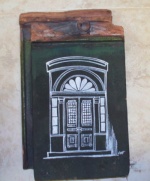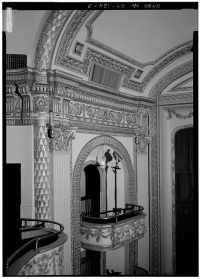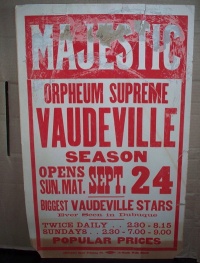Encyclopedia Dubuque
"Encyclopedia Dubuque is the online authority for all things Dubuque, written by the people who know the city best.”
Marshall Cohen—researcher and producer, CNN
Affiliated with the Local History Network of the State Historical Society of Iowa, and the Iowa Museum Association.
MAJESTIC THEATRE: Difference between revisions
No edit summary |
No edit summary |
||
| (20 intermediate revisions by the same user not shown) | |||
| Line 1: | Line 1: | ||
[[Image:THEATERHISTORY.png|left|thumb|250px|Theater History. Courtesy: Telegraph Herald]] | |||
[[Image:majestic.gif|left|thumb|250px|Majestic Theater]] | [[Image:majestic.gif|left|thumb|250px|Majestic Theater]] | ||
[[Image:tile.jpg|right|thumb|150px|This tile (8.5" x 14") was kilned in Holland for the roof of the Orpheum Theater. ]]MAJESTIC THEATER. The Majestic is the linear descendant of the [[ | [[Image:tile.jpg|right|thumb|150px|This tile (8.5" x 14") was kilned in Holland for the roof of the Orpheum Theater. ]]MAJESTIC THEATER. The Majestic is the linear descendant of the [[ATHENAEUM]], a theater constructed in 1840 in a building erected in 1833 at the corner of Fourth and Main. The Athenaeum gave rise to an amazing list of theaters which could have ended on April 7, 1910 when fire destroyed the renovated [[BIJOU THEATER]]. Almost as the ashes were cooling, however, the site was developed as the first theater designed by the Chicago firm of C. W. Rapp and George Rapp, eventually the leading theater designers in the United States. (1) | ||
[[Image:majth.png|left|thumb|250px|Advertisement.]]The Majestic, built in 1910 at a cost of $90,000 in the style of Renaissance-Flemish architecture, was said to be a replica of the famous Moulin Rouge in Paris. (2) | [[Image:majth.png|left|thumb|250px|Advertisement.]] | ||
The Majestic, built in 1910 at a cost of $90,000 by the [[DUBUQUE OPERA HOUSE COMPANY]] in the style of Renaissance-Flemish architecture, was said to be a replica of the famous Moulin Rouge in Paris. (2) Immediately popular, the theater had forty shows booked by the end of construction. (3) The theater was said to have had an audience of 14,000 the week of November 18th when it opened--one third of the city's population. (4) Audiences were held in suspense as to what might be featured next. As early as November, 1910 Rosenthal presented "Vallecita's Leopards," billed as the most sensational animal act before the public today." (5) When "Amateur Nights" were featured with the six usual vaudeville numbers and a farce by the entire company, the curtain was raised at 8:15 p.m (6) Among the stars who appeared on its stage were Ethel Barrymore and Eddie Cantor. | |||
Motion pictures were shown at the Majestic | [[Image:syncopaters.png|left|thumb|350px|Photo courtesy: Telegraph Herald]] Motion pictures were shown at the Majestic beginning in 1910 with each live performance. Movies were changed every Thursday and Sunday afternoon. (7) In June, 1917 the ''Telegraph-Herald'' featured a contest based on "Twenty Thousand Leagues Under the Sea." Interested children could clip a coupon from the newspaper and present it along with 15 cents to see the movie. When the movie was finished, they could write a short story on "What I Saw Through Captain Nemo's Submarine Window." Prizes were $5, $3, and $2. (8) | ||
Music was considered important. In the age of silent movies, Earl Wood's Syncopaters provided the music to match the action on the screen. In 1917 an innovation was announced. The audience could enjoy an orchestra of five musicians playing at all performances--matinee and at nights. This was a change from the former practice of having three musicians at the week day matinees. Led by George H. Ramig, pianist and musical director at the Majestic for several years, the orchestra included Harry Durtina, violinist; Leo Jones, trombonist; John Jenney, cornetist (and father of the great [[JENNEY, Jack|Jack JENNEY]]; and Payson Berg, drummer. The increased cost of production including amusement tax, higher salaries for performers and the increase in the orchestra led to price increases. There was a five cent increase for main floor seats---from twenty to twenty-five cents. (9) | |||
Motion pictures and vaudeville ran as the regular bill until 1927 when a new feature was promoted--"Battle of Music." Two local orchestras were seated on platforms on the stage at the same time. One played a selection and then the other. At the conclusion, the audience judged which orchestra was the "hotter" and the recipient of a cash prize. The first "skirmish" featured Bud and his Vioni Orchestra and Don and his Rag-Time Pals. When first announced on March 9, 1927 enough local orchestras had been lined up for six consecutive Friday nights. After the schedule was exhausted, the winner of each Friday night would meet in a grand tournament. The prize was a professional engagement at the Majestic in addition to a cash prize. It was suggested that an invitation might be extended to orchestras from outside Dubuque. (10) | |||
From 1910 through 1934, [[SPENSLEY, Harker Brentnal, Sr.|Harker Brentnal Spensley, Sr.]] managed the Majestic and added the title of president in 1929 when it was renamed the [[SPENSLEY THEATER]]. | |||
[[Image:interior-1.jpg|left|thumb|200px|Interior view]] | [[Image:interior-1.jpg|left|thumb|200px|Interior view]] | ||
[[Image:interior-2.jpg|left|thumb|200px|Interior view]] | [[Image:interior-2.jpg|left|thumb|200px|Interior view]] | ||
[[Image:interior-3.jpg|left|thumb|200px|Interior view]] | [[Image:interior-3.jpg|left|thumb|200px|Interior view]] | ||
[[Image:bernhardt.jpg| | [[Image:bernhardt.jpg|right|thumb|200px|Famous talent was regularly "booked" to perform. Photo courtesy: Bob Reding]] | ||
[[Image:posterv.jpg|left|thumb|200px|Photo courtesy: Bob Reding]] | [[Image:posterv.jpg|left|thumb|200px|Photo courtesy: Bob Reding]] | ||
--- | --- | ||
Sources: | Sources: | ||
1. "Theater at Fourth and Main," Online: http://fiveflagscenter.com/AboutUs/History.aspx | 1. "Theater at Fourth and Main," Online: http://fiveflagscenter.com/AboutUs/History.aspx | ||
| Line 68: | Line 30: | ||
3. Voight, Sandye. "New-Look Five Flags Shines," ''Telegraph Herald'', October 4, 2001, p. 11 | 3. Voight, Sandye. "New-Look Five Flags Shines," ''Telegraph Herald'', October 4, 2001, p. 11 | ||
4. " | 4. "The Taste for Popular Amusements," ''The Dubuque Telegraph-Herald'', November 29, 1910, p. 9 | ||
5. "Majestic," ''Dubuque Telegraph-Herald'', November 287, 1910, p. 27 | |||
6. "Amateurs Tonight," ''Dubuque Telegraph-Herald'', March 1, 1912, p. 11 | |||
7. "Majestic," ''Dubuque Telegraph-Herald'', December 17, 1910, p. 13 | |||
8. "Children Begin Clipping Coupons For Greatest Undersea Picture," ''Dubuque Telegraph-Herald'', June 28, 1917, p. 7 | |||
9. "An Excellent Opening Bill," ''Dubuque Telegraph-Herald'', September 16, 1917 | |||
10. "Majestic Theatre Will be Scene of 'Battle of Music,'" Telegraph-Herald, March 9, 1927, p. 4 | |||
11. "Chronology 1972," ''Telegraph Herald'', December 28, 1972, p. 20 | |||
Latest revision as of 20:00, 9 February 2018
MAJESTIC THEATER. The Majestic is the linear descendant of the ATHENAEUM, a theater constructed in 1840 in a building erected in 1833 at the corner of Fourth and Main. The Athenaeum gave rise to an amazing list of theaters which could have ended on April 7, 1910 when fire destroyed the renovated BIJOU THEATER. Almost as the ashes were cooling, however, the site was developed as the first theater designed by the Chicago firm of C. W. Rapp and George Rapp, eventually the leading theater designers in the United States. (1)
The Majestic, built in 1910 at a cost of $90,000 by the DUBUQUE OPERA HOUSE COMPANY in the style of Renaissance-Flemish architecture, was said to be a replica of the famous Moulin Rouge in Paris. (2) Immediately popular, the theater had forty shows booked by the end of construction. (3) The theater was said to have had an audience of 14,000 the week of November 18th when it opened--one third of the city's population. (4) Audiences were held in suspense as to what might be featured next. As early as November, 1910 Rosenthal presented "Vallecita's Leopards," billed as the most sensational animal act before the public today." (5) When "Amateur Nights" were featured with the six usual vaudeville numbers and a farce by the entire company, the curtain was raised at 8:15 p.m (6) Among the stars who appeared on its stage were Ethel Barrymore and Eddie Cantor.
Motion pictures were shown at the Majestic beginning in 1910 with each live performance. Movies were changed every Thursday and Sunday afternoon. (7) In June, 1917 the Telegraph-Herald featured a contest based on "Twenty Thousand Leagues Under the Sea." Interested children could clip a coupon from the newspaper and present it along with 15 cents to see the movie. When the movie was finished, they could write a short story on "What I Saw Through Captain Nemo's Submarine Window." Prizes were $5, $3, and $2. (8)
Music was considered important. In the age of silent movies, Earl Wood's Syncopaters provided the music to match the action on the screen. In 1917 an innovation was announced. The audience could enjoy an orchestra of five musicians playing at all performances--matinee and at nights. This was a change from the former practice of having three musicians at the week day matinees. Led by George H. Ramig, pianist and musical director at the Majestic for several years, the orchestra included Harry Durtina, violinist; Leo Jones, trombonist; John Jenney, cornetist (and father of the great Jack JENNEY; and Payson Berg, drummer. The increased cost of production including amusement tax, higher salaries for performers and the increase in the orchestra led to price increases. There was a five cent increase for main floor seats---from twenty to twenty-five cents. (9)
Motion pictures and vaudeville ran as the regular bill until 1927 when a new feature was promoted--"Battle of Music." Two local orchestras were seated on platforms on the stage at the same time. One played a selection and then the other. At the conclusion, the audience judged which orchestra was the "hotter" and the recipient of a cash prize. The first "skirmish" featured Bud and his Vioni Orchestra and Don and his Rag-Time Pals. When first announced on March 9, 1927 enough local orchestras had been lined up for six consecutive Friday nights. After the schedule was exhausted, the winner of each Friday night would meet in a grand tournament. The prize was a professional engagement at the Majestic in addition to a cash prize. It was suggested that an invitation might be extended to orchestras from outside Dubuque. (10)
From 1910 through 1934, Harker Brentnal Spensley, Sr. managed the Majestic and added the title of president in 1929 when it was renamed the SPENSLEY THEATER.
---
Sources:
1. "Theater at Fourth and Main," Online: http://fiveflagscenter.com/AboutUs/History.aspx
2. "An Idea Whose Time Had Come," Telegraph Herald, March 22, 1979, p. 25
3. Voight, Sandye. "New-Look Five Flags Shines," Telegraph Herald, October 4, 2001, p. 11
4. "The Taste for Popular Amusements," The Dubuque Telegraph-Herald, November 29, 1910, p. 9
5. "Majestic," Dubuque Telegraph-Herald, November 287, 1910, p. 27
6. "Amateurs Tonight," Dubuque Telegraph-Herald, March 1, 1912, p. 11
7. "Majestic," Dubuque Telegraph-Herald, December 17, 1910, p. 13
8. "Children Begin Clipping Coupons For Greatest Undersea Picture," Dubuque Telegraph-Herald, June 28, 1917, p. 7
9. "An Excellent Opening Bill," Dubuque Telegraph-Herald, September 16, 1917
10. "Majestic Theatre Will be Scene of 'Battle of Music,'" Telegraph-Herald, March 9, 1927, p. 4
11. "Chronology 1972," Telegraph Herald, December 28, 1972, p. 20











